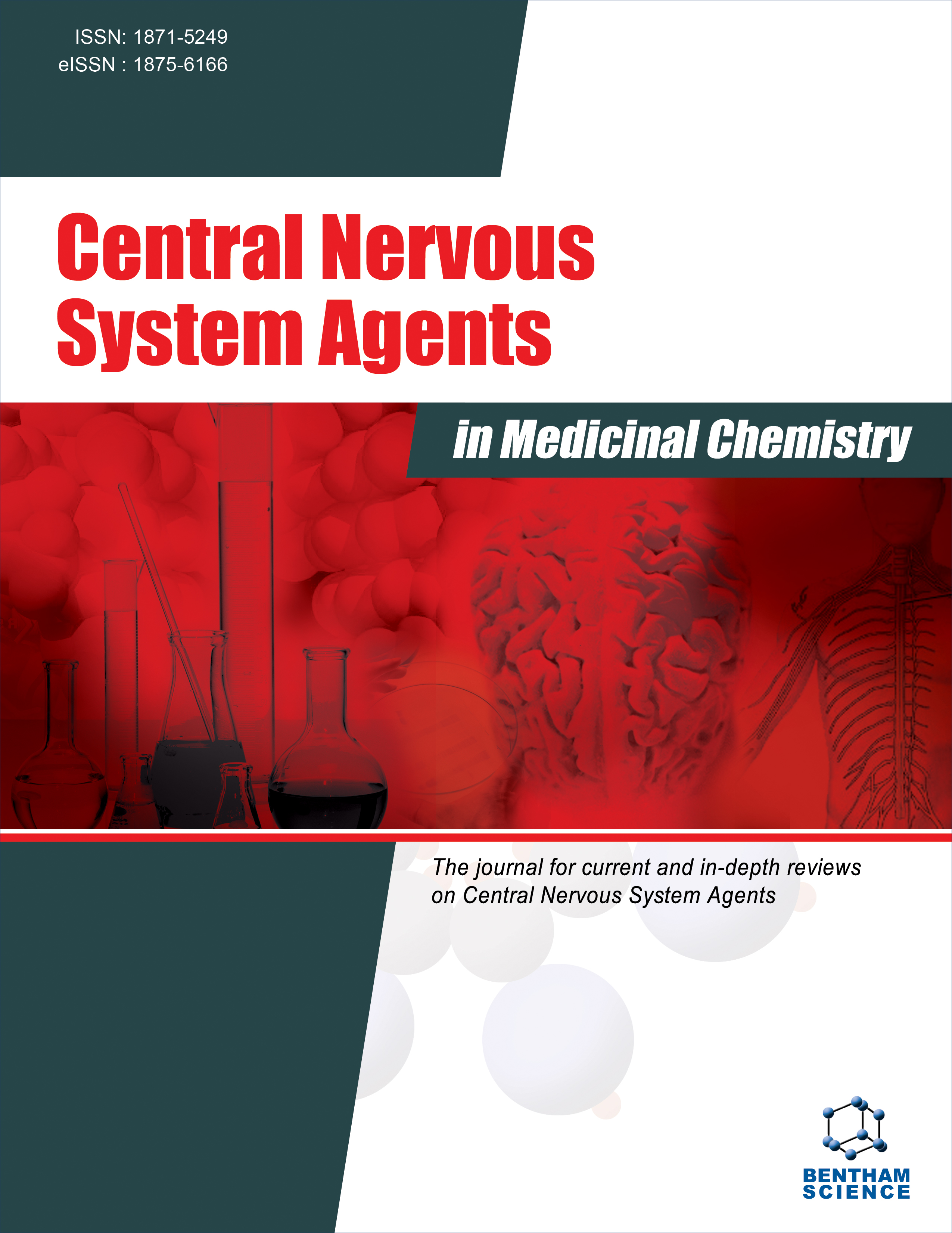- Home
- A-Z Publications
- Central Nervous System Agents in Medicinal Chemistry (Formerly Current Medicinal Chemistry - Central Nervous System Agents)
- Previous Issues
- Volume 17, Issue 1, 2017
Central Nervous System Agents in Medicinal Chemistry (Formerly Current Medicinal Chemistry - Central Nervous System Agents) - Volume 17, Issue 1, 2017
Volume 17, Issue 1, 2017
-
-
Heterocyclic Secretase Inhibitors for the Treatment of Alzheimer’s Disease: An Overview
More LessAuthors: Neeraj Masand, Satya P. Gupta, Ratan Lal Khosa and Vaishali M. PatilAlzheimer's disease (AD) is the most common neurodegenerative disorder and demands approaches for prevention and delayed onset. The development of therapeutics for AD is based on the amyloid cascade hypothesis (vaccines, β- and γ-Secretase inhibitors), or targeting tau and neurofibrillary tangle formation, neuroinflammation, etc. Cholinesterase, BACE-1, amyloid-β 1-42, γ and β-Secretase, and Phosphodieste Read More
-
-
-
Thiazolidine: A Potent Candidate for Central Nervous System Diseases
More LessAuthors: Radhe S. Bahare, Swastika Ganguly, Ritesh Agrawal and Subodh N. DikshitThiazolidines are multifaceted molecules and exhibit various kinds of biological activities including anticonvulsant and antidepressant activities, chemically thiazolidinediones is a diversified class of heterocyclic nucleus. Thiazolidinediones have shown significant biological activities in various CNS disorder. The mechanism responsible for thiazolidinediones biological activities in CNS based on thiazolidinediones- induced neuropr Read More
-
-
-
Drug Design Strategies for the Discovery of Novel Anticonvulsants Concerned with Four Site Binding Pharmacophoric Model Studies
More LessAnticonvulsant refers to a group of pharmaceuticals used in the treatment of epileptic seizures. The use of current antiepileptic drugs has been questioned due to the non selectivity of the drugs and the undesirable side effects produced by them. This led to the search for antiepileptic compounds with more selectivity and lower toxicity. Semicarbazones have been developed as versatile anticonvulsant pharmacophore. I Read More
-
-
-
Psychomotor Seizure Screening and in vitro Neuroprotection Assay of Hydrazones Derived from 2-Acetyl Thiophene
More LessBackground: Hydrazone core is a versatile structural linker for the development of various classes of antiepileptic agents. The aim of this study was to investigate the anticonvulsant activity of thiophene based hydrazones according to the antiepileptic drug development program protocol. Methods: The maximal electroshock-induced seizure and 6 Hz "Psychomotor" seizure test models in mice were performed. Additionally, Read More
-
-
-
Ligand based Drug Design of New Heterocyclic Imines of GABA Analogues: A Molecular Docking Approach for the Discovery of New GABA-AT Inhibitors
More LessBackground: Degradation of the inhibitory neurotransmitter γ-aminobutyric acid (GABA) is mainly catalysed by GABA aminotransferase (GABA-AT), excessive activity of which leads to convulsions. Inhibition of GABA-AT increases the concentration of GABA and can terminate the convulsions. Several studies have revealed that GABA analogues could be the outstanding scaffolds for the design of potent inhibitors of GABA-AT. Th Read More
-
-
-
Novel Pyrimidine based Semicarbazones: Confirmation of Four Binding Site Pharmacophoric Model Hypothesis for Antiepileptic Activity
More LessBackground: Epilepsy is a neurological disorder, characterized by seizures accompanied by loss or disturbance of consciousness affecting various physical and mental functions. Current anticonvulsant drugs are effective in controlling seizures in about 70% of cases, but their use is often limited by side effects like ataxia, megaloblastic anemia, hepatic failure. In search for a novel anticovulsant drug with better efficacy and lower t Read More
-
-
-
Understanding the Metabolic Consequences of Human Arylsulfatase A Deficiency through a Computational Systems Biology Study
More LessBackground: The nervous system is responsible for the communication between the organism and its environment. This task is possible by the presence of the myelin sheath, which is a double membrane formed by about 75% lipids and 25% proteins. The sulfatide represents one of the main lipids of the myelin band; its degradation is catabolized by the enzyme Arylsulfatase A (ARSA), to generated galactosylceramide. M Read More
-
-
-
Physiological Targets for the Treatment of Diabetic Encephalopathy
More LessBackground: Diabetes mellitus is a chronic degenerative disease responsible for hyperglycemic episodes through insulin secretion deficiency or cellular resistance. Clinical diagnosis in diabetic patients established that this disease affects the CNS, damaging the brain and impairing cognition, thus establishing a clinical diabetic condition named diabetic encephalopathy. Despite the fact that physiological mechanisms responsibl Read More
-
Volumes & issues
-
Volume 25 (2025)
-
Volume 24 (2024)
-
Volume 23 (2023)
-
Volume 22 (2022)
-
Volume 21 (2021)
-
Volume 20 (2020)
-
Volume 19 (2019)
-
Volume 18 (2018)
-
Volume 17 (2017)
-
Volume 16 (2016)
-
Volume 15 (2015)
-
Volume 14 (2014)
-
Volume 13 (2013)
-
Volume 12 (2012)
-
Volume 11 (2011)
-
Volume 10 (2010)
-
Volume 9 (2009)
-
Volume 8 (2008)
-
Volume 7 (2007)
-
Volume 6 (2006)
Most Read This Month
Article
content/journals/cnsamc
Journal
10
5
false
en


